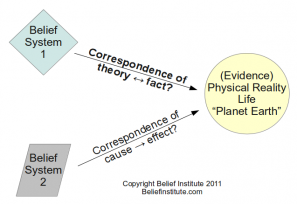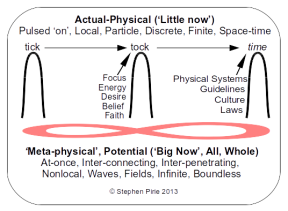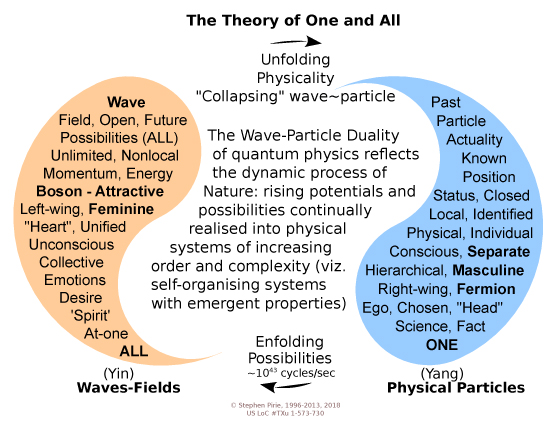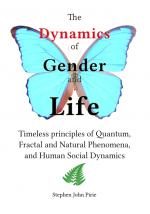Background
Modern science is still almost entirely based on 17th century concepts that physical movement is perfectly smooth and continuous.
This continuity of movement implies continuity of operation (of the world we experience) which naturally induced the perception that our universe (and our bodies) operated like a clockwork machine. This machine-world view was the impetus for the Industrial Revolution which resulted in many beneficial technologies (aircraft, automobiles, etc).
Around 200 years after Newton developed the calculus (which is based on the assumption of perfect continuity), the continuous-machine model was not able to explain a growing number of puzzling experimental results1 especially those concerning the presumed wave-like behaviour of light.
In 1905 Albert Einstein resolved the mismatch of clockwork theory with actual experiment with his photo-electric effect for which he received the Nobel Prize in Physics. Light came in "lumps" or particles of energy, and these particles, what we call "photons", were not continuous.
This "quantum" view of light gave rise to a burst of discoveries2, leading to what is now accepted as being, by far, "the most successful physical theory in history"3 : quantum theory.
Physicists quipped that quantum physics was all about "lumps and jumps" - lumps of light that "jump" from location to location without travelling the intervening space.
As one leading physicist explained, "according to the quantum theory, movement is not4 fundamentally continuous".
However, our sciences are still working on the assumption of clockwork continuity, which works well enough for rockets, rifles and railways.
Medical science, for example, still seeks to find the static machine-parts (genes) responsible for our personal behaviours, despite the evidence for nonlocal, interconnecting fields of quantum potentials that would, if researched, open whole new avenues for healing and wellbeing.
In the minutia of physical movement including when we so much as lift a finger, movement is not continuous, nor clockwork in nature, nor predictable, nor certain ... nor physical in nature, but meta-physical.
Yet our sciences carry on, as if movement was continuous and purely physical. The bulk of modern science is reliant on 17th century assumptions that are incompatible with world's most successful physical theory. The scientific method calls for theories to be discarded or modified when faced with evidence that is unable to be accommodated within the scope of a particular theory. This is how science advances. The geocentric model (Earth as centre of the universe) was ultimately replaced by the heliocentric model (Earth orbiting the Sun) because of the weight of evidence for the heliocentric model.
The intransigence to upgrade science's mechanical-universe model with one that is compatible with the quantum evidence is, like the behaviour of priests in Galileo's time, the hallmark of dogma, superstition and greed. That failure (to accommodate the facts within a congruent world-view) is a travesty of modern science.
In brief:
Standard5 modern science is still almost entirely based on 17th century concepts that physical movement is perfectly smooth and continuous (comprising an infinite-series6 of ever-so-small "infinitesimal" movements).
There are no bodily processes (chemical, electrical or otherwise) that can move anything infinitely ("infinite" literally means without end). Accordingly, physical movement is theoretically impossible when based on standard science's Newtonian (17th century) "assumptions". Given that physical movement is a routine aspect of everyday life, the root assumptions of standard science are clearly and unambiguously wrong.
Instead of applying 17th century thinking to our 21st century world, a new holodynamic world-view that matches the (quantum) evidence is, arguably, long overdue.
Detail:
Superstition - "a belief or practice resulting from ignorance, fear of the unknown, trust in magic or chance, or a false conception of causation."
While sharing various ideas on a forum recently, it became evident there are many people (including and especially atheists, scientists and the religious) who still very deeply rely on superstitious beliefs.
And by "superstitious" beliefs, none are more evident than when the topic of Zeno's Paradoxes is considered.
To put things in context:
Imagine we have a number of belief-systems, let's call them BS1 and BS2. Let's now see how well they match a particular set of evidence (facts and observations, as can be readily experienced on planet Earth).
 Consider the evidence of the physical act of movement, such as a runner running a race, an arrow flying through the air, or a dog chasing a ball. Let's take one particular case of physical movement that likely has relevance and meaning to most who consider this — the movement of one's own index finger (the first finger of one's hand, adjoining the thumb).
Consider the evidence of the physical act of movement, such as a runner running a race, an arrow flying through the air, or a dog chasing a ball. Let's take one particular case of physical movement that likely has relevance and meaning to most who consider this — the movement of one's own index finger (the first finger of one's hand, adjoining the thumb).
The evidence of movement of one's finger is easily observed, and experienced. For example, reading this page (while online) you might be using your index finger to rotate the scroll-wheel on your computer mouse).
If we begin to seek a theory to explain such an everyday phenomenon, we might use the analogy of a motion picture film.
Let's consider a specific thought-experiment. We zoom in on a test subject's finger to such an extent that we "see" one of the atoms in that finger, perhaps the very tip of the subject's fingernail. We do not need to actually see this atom, other than surmise its existence.
Now let's assume we move that finger (and thus the atom in that fingernail) one unit of length, such as 1cm. 7
If we were to take a video of that motion, how many captures, or frames would we need to take in order to "perfectly" capture every last increment in movement of that atom?
Now, here's where it gets interesting. BS1 says we must take an infinite number of "snaps" in order to capture every last increment in movement and for movement to be "perfectly smooth" with no gaps or sudden stop-start movement. To prove the point, BS1 uses a theoretical process that involves "infinite-series" of numbers (points).
By using "infinite-series" it can be mathematically proved that motion (as when we might lift a finger) is fully addressed by the application of this method.
So far, so good. We have theory matching the evidence. So it would seem.
However, there is one problem. And it's a big one8, to the extent that it "forces" all sorts of superstitions upon those who refuse to consider the facts.
Basically, when using infinite-series the assumption is made that an infinite number of very very tiny "points" (physical locations) are traversed when movement occurs — movements so tiny as to be infinitesimally small, to the point that they seamlessly blend together, providing perfectly smooth motion. At least that's the theory!
When seeking to find a cause for each of the steps (points) that the finger progresses through on its way through 1cm of travel, we cannot identify the specific cause for every last one of those steps — remember: the assumption is that there are literally an endless number of them (that's the literal meaning of infinite — endless, boundless). Physical movement through an endless series of points is an irrefutably required condition of the mathematics of infinite-series, if we are to assume that the mathematics of endless-series has anything to do, at all, with the actual process of physical movement.
So what is the cause of each step in this endless, never-ending sequence of little physical increments when we so much as lift a little finger?9
"It just happens" is the response of adherents of BS1. Sound familiar?
When we consider the human body, what physical, biological process could cause an infinite-series of physical events? How many ions would need to stimulate a finger muscle to move through an infinite-series of small movements? Furthermore, if we accept that "thinking" has some role in our ability to move our finger, then how much brain stuff is required to move our finger through that infinite, never-ending sequence of movements? In more detail, if we accept that neurons have some role in our ability to think, how many neurons are needed to fire off in order to drive an infinite sequence of movements? The alternative of neurons not being involved in said movement doesn't bear thinking about (pun intended). Picture: "thoughtless, brainless" man eating an ice-cream. Not a good look. (But I digress)
Back to basics: what physical, biological process could cause an infinite-series of physical events? Clearly there are none that could directly achieve this. Noting here that standard science absolutely and unambiguously requires linking each effect (each step in said infinite series) with some identifiable or theoretical physical cause!
In other words, a physical cause — say, an electrical impetus in the body — that can move our bodies through endless sub-Planck incremental movements, movements that are 1 trillion trillionths of the Planck length, with endlessly more that are even endlessly shorter? What's the electrical signaling in the body that can cause that?
All of which presents a dilemma - there is no direct correspondence of some finite physical cause (e.g. electrical activity in the brain) with that of some supposed infinite-sequence of physical effects.
Here's where superstition enters the picture. Note the definition: a false conception of causation. A conception of causation that has no demonstrable basis in fact, nor even a theoretical basis, cannot be considered scientifically valid — anymore than we might argue any cause as being true. For example we could argue "angels on a nearby pinhead danced so vigorously as to cause the finger to move." There is no direct evidence-based correspondence of cause with effect, so we can qualify those two beliefs (angels on pinheads, and infinite-series of sequences) as "superstitious" — at least until we see the evidence verifying the relevant correspondences.
If, however, we accept there would be a large, but finite number of increments (much easier on the brain - see figure, right), then that begs two questions:

- If physical movement involves large, but finite sequences of physical increments, what's in the gaps between each increment (noting that whatever "it" is, "it" is NOT physical)?
- How can calculus (based on infinite-series) be highly successful when detailing physical phenomena, if for such sequences there is no 1:1 correlation with any identifiable physical cause?
This dilemma (point 2) is easily resolved by appreciating that calculus "at the limit" details physical movement, but that "in the middle" (in the gaps) it is in no way able to detail physical movement10. That is to say, "at the peak" (see figure, right), calculus correlates with physicality (within limits). That said, it is simply a superstition to believe that calculus (infinite-series) can be used to detail the minutia of physical movement.
To go further, this is when and where quantum theory enters the picture.
And this is also when and where many, particularly and especially atheists, scientists, and the religious, will hold onto the superstition of perfectly continuous physical movement. Because the alternative, reasonable though it is, is too big a burden to consider.
Why? Because whatever is in the gaps, it is obviously not physical. Otherwise we're back to brainless ice-cream eaters (as in there is no strongly-correlated neurological cause for the physical movements).
It's ... literally meta-physical in nature, ubiquitous. It's the "one-stuff", the common-stock, the quantum vacuum potential, it's Bohm's Implicate Order from which all is continually unfolding (at a rate of around 18x1043 cycles per second, according to some estimates).
As many physicists have come to expect and prove, the stuff in the gaps, of whatever it is made, is obviously interacting "at-once" (nonlocally). And these connections, these immediate interactions are "present not only in rare and exotic circumstances, but underlie all the events of everyday life."11
For there to be no underlying "interconnectedness", there'd be no "cause" that could orchestrate a coincident physical existence. Our daily lives would be chaotic to an infinite extreme. We would be so lucky to even have ice-cream.
So then, why do religious, atheistic and scientific folk fail to accommodate the self-evident obviousness of the above, by persisting with superstitious beliefs?
The real reason people will persist with their superstitious beliefs in the face of glaring evidence to the contrary is quite simple: greed, fear, immaturity (cultural adolescence). [Note: see the 17 December update below!]
We will ignore the conclusions of leading physicists, who affirm that we exist within "a radically interconnected and interdependent world, one so essentially connected at a deep level that the interconnections are more fundamental, more real than the independent existence of the parts."12
SOS!
We will deny the evidence that we are all an integral part of a rich holodynamic (nonlocally interconnecting) self-organising system (SOS), in order to avoid taking any responsibility for it. Instead we can then continue to work against nature and the system, experimenting on live animals, manipulating genes without a systems perspective, plundering the biosphere because we're not responsible for it.
Failing to understand the interconnected nature of our shared reality, we end up treating native cultures with disdain, dismissing their spiritual beliefs as superstitious and without merit — even though many physicists now voice similar ideas (albeit couched in more technical terms).13
And in the process we end up debasing ourselves, distancing ourselves ever more from that which supports, nurtures and enables life.
Much more explained in Congruent solutions to Zeno's Paradoxes, and related articles.
"according to the quantum theory,
movement is not14 fundamentally continuous"
[David Bohm]
...(the idea) that space is continuous is, I believe, wrong.
Professor Richard Feynman
The Messenger Series: Seeking New Laws
BS2 - Religion
Belief system 2 (religion) is highly similar to BS1 (science) in that both apportion "blame" (assign cause) for unfortunate events to outside "forces". In the case of religion it is "God" or "Evil" or other disconnected spiritual entities. With science it is "chance".
In the sphere of religion, if a young person dies the question is typically asked "why did God have him/her die so young" or in such terrible circumstances? Such questions require obedience or subservience to some sort of independent spiritual entity that is disconnected from the marrow of life. The superstitions of modern religion are easily countered — we need only consider the nature of what the infinite means, to realise the childish nature of religious beliefs — see "The Evolution of the Human Psyche" for an overview of where and when such beliefs originated, and why they persist.
"Religion ... was for most of human history, always childlike and by definition authoritarian. It was, to be specific, a primary activity of the childhood of our humanity as a species."1
In both fields of science and religion, the disconnect that is inherent between "here" (our personal experience) and "there" (the realm of God, or "chance") necessarily forms barriers (or limits) to personal experience and potentials. These barriers, or walls form comforting cocoons for those with limited perceptions and psyche. However comforting these cocoons appear, they require limits of perception — they do not allow individuals to feel into the infinite recesses of so-called "chance" or the infinite potentials of God, to find and use their own answers.
In effect, what both science and religion are telling those who remain imprisoned in those respective belief-systems, is "YOU CAN'T GO THERE! Stay where you are. You can't venture into the infinite recesses of chance, or God. Stay powerless, ignorant, helpless."15
Science and religion (in present, limited form) are, obviously, highly disempowering.
However, religion (like science) is now starting to wash over the ignorance of these inherited superstitions by melding "Process Theology", in a similar manner to science melding "Process Physics" with everyday life.
"Process life" could be considered an overarching holodynamic systems model that spans all fields of human experience, including theology, physics, psychology and sociology.

What does "holodynamic system" mean?
This section "what does 'holodynamic system' mean?", has been moved to a separate post
Update 17 December, 2015
In having (just this morning) read of an article stating that the work of Deepak Chopra was found (in one experiment) to be indistinguishable from that of random meaningless statements, and having seen the vehemence of the commentary pertaining to Chopra and "pseudo-science", I asked myself again, "why the vehemence, why the anger?"
And I was surprised to realise it's not greed, although that may still be the case, but something else, something good! ...
"why the vehemence (for people like Chopra), and I think, when I recall my days as an outspoken atheist, that it was care for those who could be easily swindled. It was my concern they were pursuing ideas or beliefs that would be ineffectual in helping them achieve betterment.
And if that be the motive of the majority of those commenting here — well and good. I respect that. But that deserves a better analysis of the underlying (implicate) reality that can be, and is, used for betterment, rather than simply throwing the proverbial baby out with the bath-water.
Update 18 December, 2015 - WOW!
In having quoted Diarmuid O'Murchu, on the same forum (see update 17 December, above), I realised something that, now in hindsight, is obvious. First the quote, then the realisation:
"All major religions reinforce the great paradox of losing one's life to find it anew. It makes no logical sense, yet intuitively and experientially we know it holds truth ... It is salutatory to learn the wisdom of letting go rather than continuously battling it out forever striving to be a winner, which is often a subconscious fear of losing control. By embracing letting go in a more wholesome way we become compassionate, caring, and more at peace with our paradoxical universe."
Skeptics and affiliated spiritual naysayers don't (by definition) embrace the paradox of the physical and the inarguably meta-physical or "spiritual" source of all life.
Embracing paradox = more at peace with our paradoxical universe. That follows, somewhat easily.
No embrace, no peace. Angry as.
Wow! Didn't see that before, obvious as it is.
Update 16 January, 2016 (Paradox explained)
In various discussions I've had recently (with those introduced to the concept of paradox), it seems there is a clear need to explain that paradox, used in these posts, does not mean "opposite"16, but something far more. Paradox, as used, and implied throughout this site, and in my work, means the complementarity of finite and infinite! Always. No exceptions.
The masculine (as is experienced within present culture) leans towards specialisation of the serial-finite (structure, science, detail) via "one-step-at-a-time" reasoning.
The feminine leans into, and subtly embraces wholeness, infinite in scope17 via at-once/parallel awareness generally known as intuition.
More is covered in "The importance of understanding masculine and feminine."
- 1. Chiefly, the photo-electric effect whereby a greater intensity of light did not produce the expected higher energy electrons; also the UV Catastrophe, and the associated "atomic catastrophe" whereby according to classical /Newtonian physics, orbiting electrons under constant acceleration must radiate photons, and quickly spiral into the nucleus.
- 2. Too many to list, but chief among them, "the most profound discovery of science," Bell's Theorem (proof of nonlocal, faster-than-light influences); Heisenberg's Uncertainty Principle; de Broglie's wave-nature of all matter; John Wheeler's Delayed Choice experiments indicating nonlocal influences across time, and others.
- 3. "we believe quantum theory because of its enormous experimental success: it really has been the most successful physical theory in history", source: Paul Davies, J.R. Brown, "The Ghost in the Atom", quoting David Deutsch, University of Oxford
- 4. Bohm's emphasis
- 5. Standard science, as defined in this post, is used synonymously with deterministic science which requires that for each physical effect, there is a (at the very least a theoretical) physical cause.
- 6. In this article, "infinite-series" is used interchangeably with infinite sequence, as the technical differences in definition are not relevant to the arguments presented.
- 7. The actual distance moved is irrelevant — it can be two centimetres, five inches or five miles, etc. The process of movement is what is important.
- 8. Nay, the problem faced by standard science is so extraordinarily huge, that it is ignored, avoided, denied. See The Travesty of Modern Science".
- 9. Noting here that "momentum" or "inertia" cannot be assigned as the cause, since momentum (p) (which equals h/λ) is a property, like velocity, not a cause for said velocity or momentum. See 3rd Proof of the Impossibility of Physical Movement
- 10. If infinite-series/calculus were able to account for all physical movement, we could entirely dispense with quantum theory — the world's most successful physical theory in history!
- 11. Nick Herbert, Quantum Reality: Beyond The New Physics.
- 12. Victor Mansfield, Synchronicity, science and soul-making.
- 13. See "Timeless Knowledge" and related articles
- 14. Bohm's emphasis
- 15. The subtext of which is, "so we can more easily control you." Note how religion is emphatically hierarchical with God "up there", smarter, stronger, wiser, us down here, dumber, weaker and ignorant, followed by the Pope as top dude, with bishops and others of lesser hierarchy, and so on. In science, there is a hierarchy, just not as evident, or explicit. This article, for example, supplies straight-forward reasoning to undermine the vast bulk of contemporary scientific belief, yet it does not (as of late 2017) ascend to the top of the accepted-theory hierarchy, despite the self-evident obviousness of the content.
- 16. It makes no sense to say the individual is "opposite" the community, since the individual is the community-as-the-individual — see Key Principles, Belief Institute
- 17. Hence why such aphorisms, as "feminine mystique", never "masculine mystique"!, and "it's a woman's prerogagive to change her mind" among the limitless, fluid possibilities within the infinite
